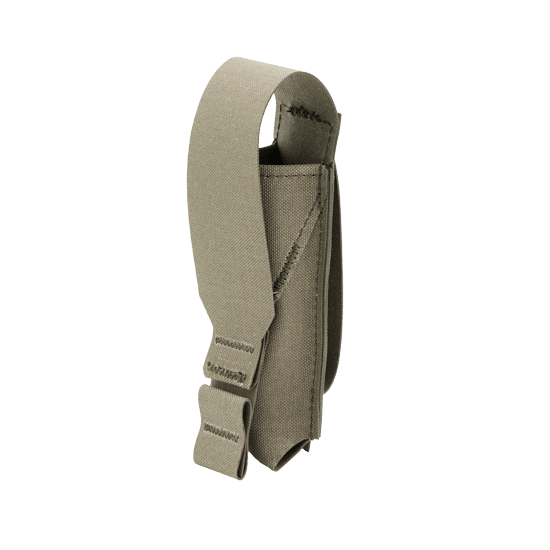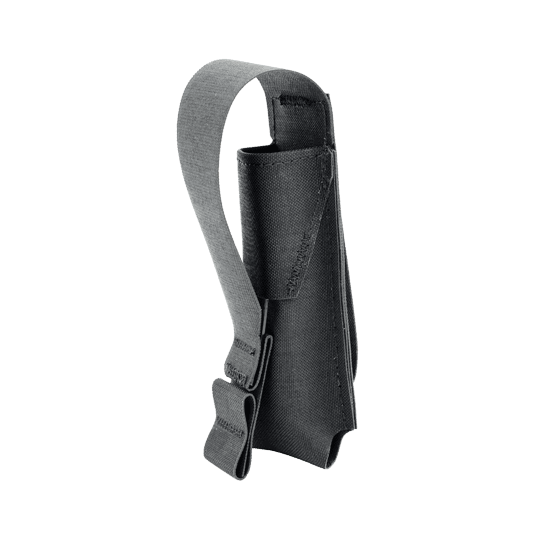The Laserluchs PICO-TRACKER-V2
The protected, mobile laser unit for the detection of trigger wires in explosive and incendiary devices
Background information on booby traps and incendiary devices
Unconventional Explosive and Fire Devices are used world-wide in war and terrorist activities, mostly against soft targets. A booby trap is defined as follows: “A device or substance designed, constructed and intended to kill or injure, and which unexpectedly activates when a person removes or approaches an apparently harmless object or takes an apperently harmless action (definition according to the Geman Federal Law Gazette).

These booby traps or incendiary traps are often built from readily available explosive substances. Their production is relatively simple, so that no industrial infrastructure is required. Often the simplest easily available means such as fertilizer and a suitable initiator are used to produce an Unconventional Explosive and Fire Devices. The English term Improvised Exploive Device (IED) is used synonymously in military parlance as an abbreviation for unconventional explosive and incendiary devices. There are practically no limits to the camouflage of IEDs, which makes it difficult to identify and find them. Often the booby traps are placed into seemingly harmless movable objects such as beerage cans or containers, mail parcels, children‘s toys or household items. They are installed to detonate when approchad, touched or moved.
The use of booby traps constitutes a violation of the Hague Land War Regulations and their successor contracts, since, in principle, no distinction is made between civilians and soldiers when detonated. Most western countries have therefore banned the use of booby traps by law and in compliance with the principles of the Geneva Conventions, which are intended to ensure the protection of non-combatants in the event of armed conflict.
How are booby traps triggered?
Typically, an IED is activated by a direct, intervening mechanical trigger, e.g., a trip wire, which is usually just above the ground or floor (ankle to knee height) and from a fixed anchor point connected to the trigger, which is struck. Any kind of movement of the trip wire leads to a linear movement at the trigger, which, depending on the construction of the booby trap, removes a safety pin and thus causes the ignition, or closes the contact of an electrical primer to trigger the detonation. Also known are triggers which are designed as inductive/capacitive proximity sensors, radar sensors or PIR sensors, and react to proximity or movement or to body heat radiation. By using mercury inclination sensors, pressure switches, microswitches or acceleration sensors, the booby trap detonates immediately when it moves or changes position. In some cases, the ignition is triggered remotely, e.g., via wire or radio signal. In the simplest case, a time-controlled trigger is activated by a converted kitchen timer which triggers the detonation after the set time expires. Technologically more complex IEDs can alternatively be triggered with the aid of a light barrier/optical fibers or by remote ignition with radio signals from suitable transmitter/receiver units or by targeted mobile radio signals.
In Afghanistan and Iraq in particular, many booby traps were triggered with mobile radio signals. This circumstance led the coalition armed forces to the increased use of so-called LED jammers, which act as a jamming transmitter and are able to operate in a sufficient area around the transmitter to disrupt radio signals in such a way that the triggering by radio can be safely prevented. To increase the lethal effect of booby traps, additional metal parts are often arranged around the explosive core, such as nails or ball bearings, which can work as fragmentation grenades or projectile-forming charges when detonated. The majority of IEDs are constructed purely mechanically; these booby traps do not require maintenance-prone batteries or electronics and are not susceptible to external weather influences. The classic trip wire is still by far the most common implementation.


In practice, the trip wire is made from commonly available materials such as thin metal wires, yarn and fishing lines. In order to effectively camouflage the trip wire of an IED, bright colors are usually used for light backgrounds; for dark backgrounds, dark colors are used. The use of transparent monofilament wires, e.g., fishing lines, represents the biggest challenge to perceptibility since they are optically very difficult to detect and melt into the ambient light.
Armed forces and special forces around the world have developed a variety of ways to deal with this threat. The technologies used range from IR remote jamming systems, metal detectors, radio jamming to optically stimulated detection methods. In principle, however, these technologies can only be used safely on IEDs that have such triggering mechanisms. Because of extensive and targeted use of IEBVs during the Iraq war, the proportion of coalition forces soldiers directly killed by booby traps was 40%. In comparison, the proportion of soldiers killed in direct combat was 33%. These figures clearly illustrate the high risk posed by the use of prohibited booby traps, so it should be an important goal to improve the detectability and defusing of IEDs to protect the lives and health of the soldiers.
Detection of explosive devices with the PICO-TRACKER-V2
With the current state of the art, trip wires are usually detected using line lasers. The area to be examined, in which the presence of a trip wire is suspected, is completely scanned several times. When illuminated with a laser line, either selectively or, depending on the overlap, over a complete section of the trip wire, tensioned release wires reflect back to the operator, and the light reflection can be used to reliably determine the location of the release wire.


This can be accomplished with the help of a line laser that is visible to the human eye (where no additional aids are required for the viewer because the reflection of the line laser is sufficiently recognizable with the naked eye), as well as in the invisible wavelength range with the help of an infrared line laser. This solution, in which an infrared line laser is used in conjunction with a night vision device, enables the detection of a trip wire even in total darkness. The combination allows an examination of the area in which a trip wire is suspected to go completely unnoticed.
This is a decisive advantage both for the military and for special units engaged in the fight against terrorism. Due to the high sensitivity of the night vision device, a significantly reduced light output of the infrared line laser is sufficient to ensure reliable detection of a trip wire. Another advantage of the greatly reduced light output in the infrared range in this case is the negligible forward signature of the line laser, which does not trip any photosensitive trigger sensors in the booby trap.
Known line lasers emit either in the visible or in the invisible wavelength range (infrared range). Several versions of line lasers are known in which either only the visible laser source or only the invisible IR laser source is encased in a mobile housing. As a result, the user must always carry both versions in order to be prepared for all cases. Especially in military use, there is a latent danger of confusing the two housings in insufficient light conditions, so that a covert operation could possibly be endangered by the illumination of a visible laser pulse.
The PICO-TRACKER-V2 is based on the task of providing a combined laser unit for the detection of trigger wires in booby traps, which eliminates the disadvantages of the product features previously on the market.
The implementation of all specifications takes place in a compact housing of 25.4 x 133mm length, with a weight of only 137 grams. In addition to the power supply (2 x CR123A batteries) there is also a visible laser source with 520nm / 15mW and an invisible laser source with 850nm / 1mW which enable precise line projections. The tracker is operated by a mechanically locking, multi-stage switch that switches through the switching stages of the individual laser sources (invisible / visible) one after the other. With the switching function of the visible step, an additional mechanical lock has to be activated manually in order to protect against incorrect operation and inadvertent switching on of the visible wavelength of the laser. The switch unit was also designed in such a way that it can be operated comfortably with gloves in winter or with protective gloves. The switching states of the tracker are visualized by means of an optical glass fiber on the back of the switch so that the operating state can be reliably identified in all situations.
The implementation of the official requirements and the subsequent further development of the first prototypes ultimately led to the current version PICO-TRACKER-V2. This is a new development which is unique according to the state of the art. For this reason, it was possible to register a property right for the new development, which excludes replication by other companies.
In addition, we also offer custom-fit holsters:
Your contact person
Do you still have questions? We will be happy to support you.

Madlen Klötzer - Sales Manager LASERLUCHS®
Phone: +49 261 983 497-80
Email: info@laserluchs.de


